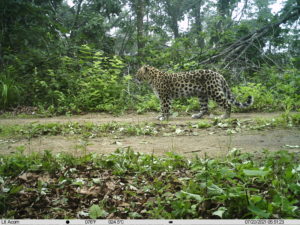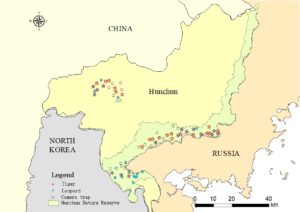Northeast China has been identified as an important destination for big cats dispersing from source sites in Russia. With support from WildCats Conservation Alliance, Wildlife Conservation Society (WCS) has documented this increase and the establishment of fledgling populations of Amur Leopards & tigers in China.
WCS has been working in northeast China since 1998 and has been instrumental in the creation of safe places for both Amur tigers and Amur leopards to roam. The team works in Hunchun Nature Reserve (HNR) which is now a part of the newly established Northeast Tiger and Leopard National Park (NTLNP), the largest tiger and leopard reserve in the world and 50% larger than Yellowstone National Park in America.

Amur leopard in Hunchun Nature Reserve 2021 © WCS

Why this is important
It is estimated that there are probably fewer than 540 Amur tigers in the world and the Amur leopards’ plight is even more precarious, with under 100 left. Historically, the largest and most productive big cat habitats were found in Northeast China, however, development in the nineteenth and twentieth century led to habitat loss and intensive hunting. Today, most Amur tigers and leopards reside on the Russian side of the Manchurian Mountains, but the majority of available habitat is on the Chinese side.
After teetering on the verge of extinction, populations of both Amur tigers and leopards are slowly rebounding. To accommodate these growing numbers, China has set aside a vast territory by establishing the HNR and LTNP. It is hoped this protected area will bolster populations of the endangered big cats and will enable the animals to roam between the two countries.
2021 report from WCS China
During the year WCS continued two studies recording the movements and individual tigers and Amur leopards. The team identified 16 individual tigers and 16 individual leopards in HNR, including 2 tiger family units, and identified 4 individual tigers and 3 individual leopards in Dahuanggou. Across the camera trap sites some areas picked up both Amur leopards and tigers showing that both animals are successfully using this habitat.
Importantly, these cameras also pick up other species in addition to human activity. Analysis of this data shows that human activity accounted for 87% of all camera trap images captures, with cattle grazing being an issue in Dahuanggou. Where cattle are grazed there are fewer wild deer, and the team suspect that tigers rely predominately on livestock for much of the year in this area. Moving cattle out of the forests, and zoning forests so that some tracts are still available for foraging cattle will be a key component of the recovery of tigers across northeast China.
Data suggests that with the correct interventions these populations are rising.

Sika deer in HNR © WCS

Amur tiger Hunchun 2021 © WCS



